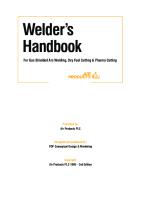Electroslag Welding
ELECTROSLAG WELDING What is electroslag welding ? •Electroslag Welding is a welding process, in which the heat is gen
Views 111 Downloads 3 File size 474KB
Recommend stories
- Author / Uploaded
- Gopal Jetani
Citation preview
ELECTROSLAG
WELDING
What is electroslag welding ? •Electroslag Welding is a welding process, in which the heat is generated by an electric current passing between the consumable electrode (filler metal) and the work piece through a molten slag covering the weld surface.
•(ESW) is similar to electrogas welding, but the main difference is the arc starts in a different location.
process • Prior to welding the gap between the two work pieces is filled with a welding flux. • Electroslag Welding is initiated by an arc between the electrode and the work piece (or starting plate). • Heat, generated by the arc, melts the fluxing powder and forms molten slag.
• The slag reaches a temperature of about 3500°F (1930°C). • This temperature is sufficient for melting the consumable electrode and work piece edges. • Metal droplets fall to the weld pool and join the work pieces. • The slag, having low electric conductivity, is maintained in liquid state due to heat produced by the electric current.
Uses • Electroslag welding is used mainly to join low carbon steel plates and/or sections that are very thick. • It can also be used on structural steel if certain precautions are observed.
• This process uses a direct current (DC) voltage usually ranging from about 600A and 40-50V, higher currents are needed for thicker materials. • Because the arc is extinguished, this is not an arc process.
Advantages •High deposition rate - up to 45 lbs/h (20 kg/h). •Low slag consumption (about 5% of the deposited metal weight). •Low distortion. •Unlimited thickness of work piece.
Disadvantages •Coarse grain structure of the weld. •Low toughness of the weld. •Only vertical position is possible.









